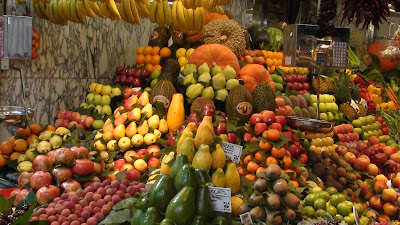Monday, September 19th
After the included breakfast at the Caldonian Hotel. We took a taxi with Bill and Miriam to Mercat de Sant Josep de la Boqueria, more often referred to simply as La Boqueria. This huge open air market has been a favorite both with tourists and with city residents.
Although there must surely have been open air markets as early as 15 B.C. in the town that was to grow into Spain's second largest city with a population of more than 5 million, the present Boqueria was not completed in its present location just off La Rambla until 1853.
In just the small section we were able to explore we were impressed by the variety of foods artistically arrayed in colorful geometric patterns.
Leaving the market, we rambled down La Rambla, one of Barcelona's most charming features. A broad avenue, shaded by overspreading plane trees, is given over primarily to pedestrian use. Narrow automobile traffic lanes run down each side of the wide central section where vendors' booths sell an incredible range of goods.
News stands, pet supplies and pets, bird vendors, fresh vegetables, books, clothing, shoes, candy, displays of tourist trinkets compete for attention with buskers playing music and performance artists attired in amazing outfits holding as still as statues, waiting for the clink of a coin in their collection to animate them.
 We took a side street off La Rambla toward the Barri Gòtic, the oldest part of the city where many of the buildings date from medieval times, and some as far back as the Roman settlement of Barcelona.
We took a side street off La Rambla toward the Barri Gòtic, the oldest part of the city where many of the buildings date from medieval times, and some as far back as the Roman settlement of Barcelona. Eventually we found a bus stop on the Red Line, and climbed to the upper deck for a ride to La Sagrada Familia, a Roman Catholic church designed by Antoni Gaudí, and perhaps the most famous Barcelona landmark.
The architectural works of Gaudí are known for their modernistic flowing lines, unusual themes taken from his view of nature, the use of broken tile facings and mosaics, and catenary arches - the curve assumed by a hanging rope. When flipped over, the catenary arch distributes any load placed on it evenly over the entire span.
Gaudí was not widely admired or accepted in his time. One of his now appreciated designs, Casa Milà, was disparagingly referred to as "La Padrera"...the rock quarry!

When Gaudí took over the design of La Sagrada Familia in 1883 at the age of 31, he included Gothic, curvilinear, and Modernism forms with impressive structural columns and catenary arches, including a rich variety of Christian symbols. A hundred and twenty eight years later the construction still continues. It is projected to be completed by 2028, 145 years after it was started.
Back on the Red Line we continued our loop, getting off at the waterside stop of Maremagnum. We found a lovely restaurant overlooking the boats, and enjoyed a delicious seafood paella dinner while we watched the sun set behind the hills across the harbor.
After our last dinner in Spain we headed back to the hotel. Passing the statue of Columbus, it seemed that he was pointing the way for tomorrow's flight.















No comments:
Post a Comment